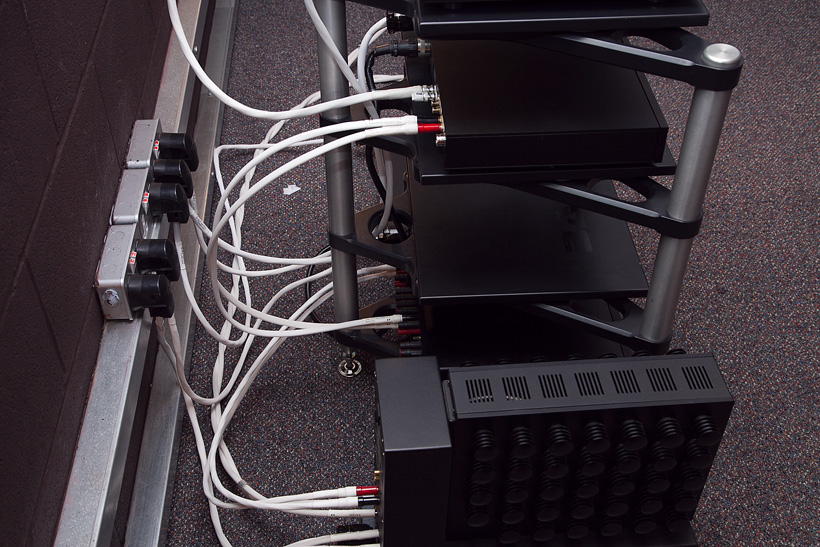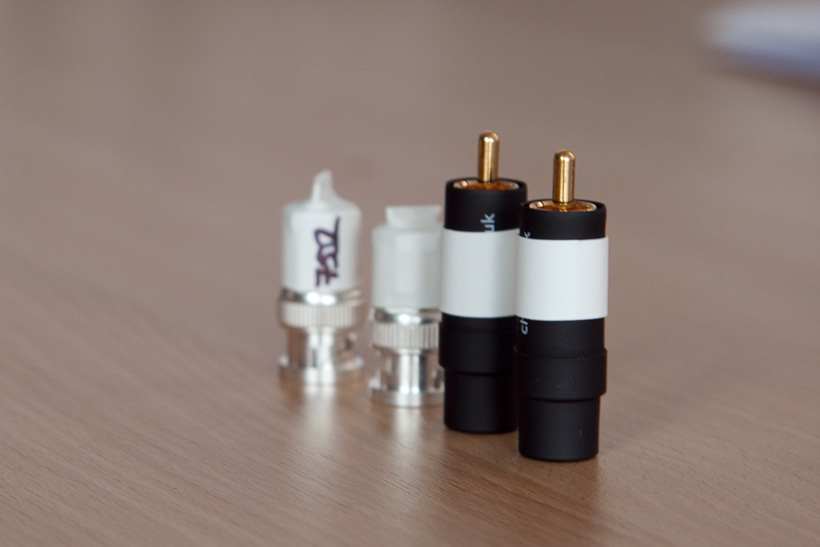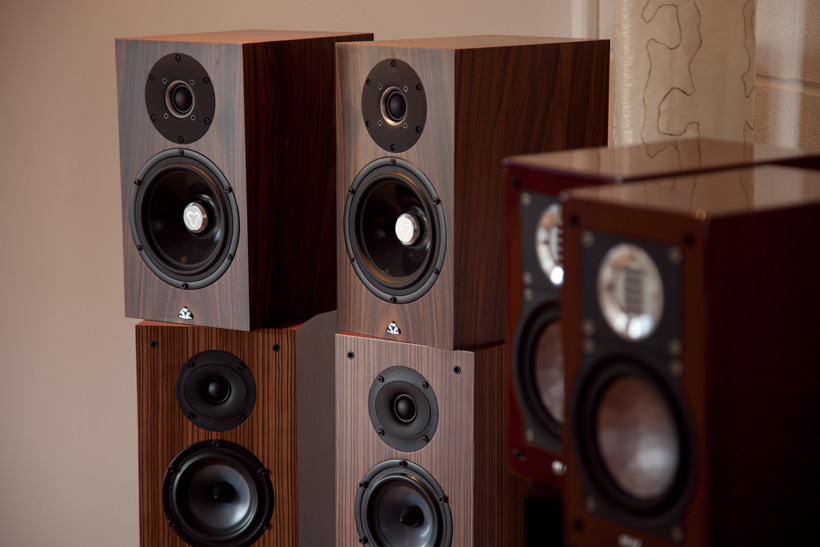Chord Co has recently made such a dramatic breakthrough with the design of its interconnects that the world needs to know what has been going down in the sleepy Wiltshire town of Amesbury. R&D supremo and music aficionado Nigel Finn invited me down to the factory to see how they do things and to hear the effects of his Tuned ARAY upgrades to their cables. Both experiences were impressive but the listening bit was a major distraction – it went on way longer than duty required.
Chord Co has been making cables since Sally Gibb started the company in her front room in 1985, today it takes up four units on the Solstice Park industrial estate and employs 24 people, almost all of whom have spent time terminating cables on the factory floor. I had a go at this myself when Mike Robinson showed me the process of assembling, preparing and terminating a run of the new Epic Reference speaker cable. This involves clamping and twisting the two separate cores of coaxial cable, the twisting bit being a three man job requiring one person at either end of hte cable and another braiding them together. Next came the 'gattling gun' a remarkable piece of equipment that strips the three layers of the cable at different depths into the casing in a matter of seconds. A job that would take an expert significantly longer with hand tools. The first stage of termination is to crimp a plug onto each strand, this clamps around the inner layer of insulation and holds the plug in place so that it can be soldered. I asked about the pros and cons of non-soldered terminations like those used by other cable companies and discovered that in Chord’s view solder sounds better. Naturally it's not just any solder, it's a silver solder that was selected on the basis of sound quality by Nigel in the company dem room. It's not surprising that such things sound different but interesting that the selected solder is not necessarily the most expensive.

Chord Co uses a very meaty soldering iron from the plumbing trade, it’s effectively a large pair of pliers that get very hot. These make terminating speaker cables which can conduct heat very efficiently a lot easier than conventional irons, neither do they cost a fortune should you be inclined to roll your own cables. The final stage is to put a case on the plug which protects the joint prior to sealing with heat shrink over a stationary heat gun. The arrow on the cover is aligned with the pin on the plug, I’d not noticed that before. The 4mm plugs that Chord Co use are not the bright shiny type seen on many a speaker terminal but have a duller 24 carat gold plating, apparently it's silver in the plating of cheaper parts that makes them so shiny but less impressive when it comes to sound quality.
It's not hard to see why it takes an hour to build a set of Sarum speaker cables. Dealers are also encouraged to visit and learn how to build cables, a process that lets them see how to do the job properly and discover what goes into the process. The top speaker cables are only available with factory terminations but models up to Epic Twin can be put together by the dealer.

Things weren't quite so organized in the early days, when Cobra Mono interconnect won a What Hi-Fi? Award in 1994 the upsurge in demand almost killed the Chord Co. Turnover tripled overnight and the company had to expand in order to cope with the demand. It moved to bigger premises and quickly outgrew them and it was some time before they found their current facility which seems to contain both some rather good film and music posters and a wide variety of audio equipment, that and an orange wall – always a good sign in my book. The extensive hardware collection has built up because Chord Co likes to see how its cables perform with all sorts of equipment, this helps them to develop products that are as broadly compatible as possible. One reason why cables make a large difference from system to system lies in the electrical interaction between cable and electronics, the unpredictability of this interaction is what Tuned ARAY seems to be better at combating than anything the company has made in the past. It also brings out a lot more of the potential in different equipment if the demonstration I heard is anything to go by.

There were plenty of speakers outside the dem room but the pair that are currently in favour are Spendor's D7 floorstanders. These started out being driven by a pre/power combo from German company Bonnec with a Sony XA5400ES SACD player acting as a transport and connected to a Naim DAC. The whole system was wired up with Sarum from the mains to the speakers, hence the array of white cables against the black electronics. Nigel kicked off with a track by Steel Pulse from the Handsworth Revolution album and went from original Sarum digital interconnect to the new Tuned ARAY version. The result was jaw dropping. Sound became music, the band started playing as one and this unusual track pulled itself into a fine example of the art. In essence the musicality, the realism and the sense of coherence were enhanced to a degree that I don’t ever recall hearing so vividly. When I attempt to analyze why this happened I can point to an increase in resolution and at the bottom end at least an increase in bandwidth, instruments sounded more realistic and thus easier to identify but the sum of these parts was nowhere near as great as the whole. How can the conductor configuration make so much difference?

We tried another piece, Walking on the Moon by the Police from a compilation of their hits, this sounded unpleasantly steely and bright initially but going over to TA pulled the musical presentation together so effectively that the tonal balance was no longer an issue. I could appreciate the character of the cymbals and the skill of Stuart Copeland without any distraction. This was made even plainer with Bruce Springsteen’s song Roselita which is a full on all guns blazing piece that sounds pretty uncomfortable at high level in a revealing system like this. TA doesn’t tame it but reveals that there is space in the recording and that the sound is made up of numerous musicians playing in time with one another and with considerable enthusiasm.

We switched amps at this stage to a Naim NAC 202 preamp and NAP 200 power amp, we also started playing files from a USB stick in the Naim DAC. The connections changed to TA versions of the same were DIN to DIN (DAC to pre) and SNAIC (pre to power) cables. At which point Nigel discovered that his fully run-in DIN to DIN was not to be found so we used a brand new sample which is apparently a limiting factor with Sarum. Nonetheless the change produced by the Tuned ARAY was dramatic, notes stopped and started more precisely and unclear sounds were now easily identified, timing was massively improved and these factors colluded to produce a powerful sense of live music being played in front of us.

I am now awaiting some Tuned ARAY digital cable to try in my system so that it can be compared with references from other brands, and if I can get the results I heard in the Chord dem room I will be very happy indeed.
Tuned ARAY is not available on all the Chord Co cables, the entry level digital cable is Anthem at £200 and the least expensive analogue interconnect is Signature at £765 for a metre pair. Sarum analogue and digital are the same price, £1,600 for a metre.

Nigel's latest tip: shorting plugs for digital inputs

Kudos Super 10, a speaker that uses Chord Co cables inside

Some of the reference speakers and Sally's old piano

Nigel's Americana


